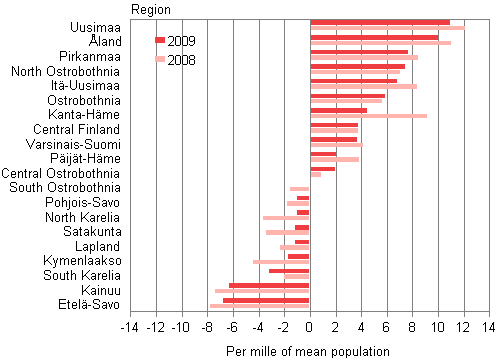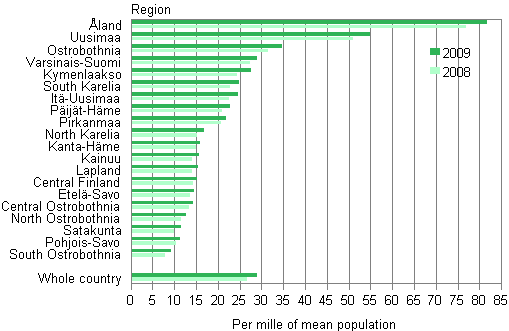Published: 30 September 2010
The population development of regions is going into different directions
In 2009, population increased in 12 regions, having grown in 11 in the previous year. Population decreased in eight regions. In these eight regions population has decreased continuously for at least the past 15 years. As regards the development of population, Finland’s regions show two opposite directions, as in eight regions population has respectively increased continuously for at least the past decade.
Relative population change of regions in 2008 and 2009

Relative population growth was largest in Uusimaa (11.0 per mil), Åland (10.1 per mil) and Pirkanmaa (7.7 per mil). The largest relative population decrease was recorded in Etelä-Savo (6.8 per mil), Kainuu (6.3 per mil) and South Karelia (3.2 per mil).
A continuous decrease in population has consequences. The age cohorts giving birth will decrease in size in future, as migration loss removes young people away. For the past 10 years, the excess of births, that is, the surplus of births over deaths has been negative in the regions of South Karelia, Etelä-Savo, Kainuu, Kymenlaakso, North Karelia, Pohjois-Savo and Satakunta.
Population development of municipalities
The reduction in the number of municipalities has accelerated with the recent municipal mergers. In 1970 Finland still had 518 municipalities. Over the 1970s the number of municipalities fell rapidly and in 1980 it stood at 464. The number of municipal mergers has gone up again in the 2000s. Four municipal mergers took effect as of the beginning of 2010, in consequence of which the number of municipalities decreased by six. At the moment there are 342 municipalities in Finland.
A summary of population changes in municipalities in 2009:
-
Population declined in 199 municipalities (58 per cent of municipalities)
-
Number of deaths exceeded that of births in 201 municipalities (59%)
-
173 municipalities experienced migration loss (51%)
-
Number of deaths exceeded that of births and total net migration was negative in 124 municipalities (36%)
The number of foreign citizens in Finland is the seventh lowest of EU27 countries
The share of citizens of foreign countries is 2.9 per cent of the population. Finland has a relatively low number of foreign citizens. According to the 2008 statistics, Finland had the seventh lowest proportion of foreign citizens in total population of all the present EU27 countries.
Of the foreign citizens residing permanently in Finland, 98,382, or 63 per cent, were citizens of European countries. More than one-half (56,106) of them were citizens of the EU27 Among the citizens of foreign countries, citizens of Asian countries numbered 33,540 (22%), citizens of African countries 15,843 (10%) and citizens of other countries or with no known citizenship 7,940 (5%).
One-half of the foreign citizens live in the region of Uusimaa. The foreign population centres specifically in Helsinki. Helsinki is the home of 26.8 per cent of all foreign citizens resident in Finland and they represent 7.2 per cent of Helsinki’s population. In Espoo the corresponding proportion is 6.3 per cent, in Vantaa 6.0 per cent and in Turku 4.7 per cent. In relative terms, the largest number of foreign citizens (8.2%) live in the Autonomous Territory of the Åland Islands. Fifty-one per cent of them are Swedish citizens.
Citizens of foreign countries by region in 2008 and 2009

Source: Population Structure 2009, Statistics Finland
Inquiries: Markus Rapo (09) 1734 3238, vaesto.tilasto@stat.fi
Director in charge: Jari Tarkoma
Publication in pdf-format (392.9 kB)
- Reviews
- Tables
-
Tables in databases
Pick the data you need into tables, view the data as graphs, or download the data for your use.
Appendix tables
- Sizes of municipalities by region 31.12.2009 (30.9.2010)
- Married women by duration and order of marriage 31.12.2009 (30.9.2010)
- Females aged 15 - 74 by number of live-born children 31.12.2009 (30.9.2010)
- Males aged 15 - 74 by number of live-born children 31.12.2009 (30.9.2010)
- Women by age, number of children and the proportion of those having given birth 31.12.2009 (30.9.2010)
- Men by age, number of children and proportion of fathers 31.12.2009 (30.9.2010)
- Religious affiliation of the population by age 31.12. 2009 (30.9.2010)
- Religious affiliation of the population 2003 - 2009 (30.9.2010)
- Figures
- Quality descriptions
-
- Quality description: Population structure 2009 (30.9.2010)
Updated 30.9.2010
Official Statistics of Finland (OSF):
Population structure [e-publication].
ISSN=1797-5395. Annual review 2009. Helsinki: Statistics Finland [referred: 16.12.2025].
Access method: http://stat.fi/til/vaerak/2009/01/vaerak_2009_01_2010-09-30_tie_001_en.html

